Iron ore production by Rio Tinto in the Pilbara region of Western Australia increased by 10% from the second quarter of 2019, when operational difficulties hit forecasts

Rio Tinto's Q3 2019 Pilbara iron ore production has rebounded after earlier setback (Credit: Rio Tinto)
Rio Tinto has today confirmed its iron ore production in Pilbara, Western Australia has made a “good recovery” in the third quarter — after having revised down its targets for the commodity earlier in the year.
The Anglo-Australian mining giant reported 87.3 million tonnes of iron ore production during the period — a 10% increase compared with the second quarter of 2019, and a 6% year-on-year rise.
In June, operational issues at the key Greater Brockman mining hub led Rio Tinto to cut its annual iron ore production targets from between 333 million and 343 million tonnes to between 320 million and 330 million tonnes.
Rio Tinto Pilbara iron ore production boost leads to increased shipments
Shipments from Pilbara of the mineral, which is used in the steel-making process, grew by 5% year-on year to 86.1 million tonnes.
CEO Jean-Sébastien Jacques said: “We have delivered improved production across the majority of our products in the third quarter, with a solid result at our Pilbara mines driving increased sales of iron ore into robust markets.
“Our strong value over volume approach, coupled with our focus on operational performance and disciplined allocation of capital, will continue to deliver superior returns to shareholders over the short, medium and long term.”
Earlier this year, Rio Tinto announced plans to overhaul its iron ore production facilities in Pilbara, earmarking around $2.2bn over the next three years for replacing mines at its Koodaideri, West Angelas and Robe Valley projects in the region.
Rio Tinto lowers production forecasts for bauxite and alumina
Rio Tinto provided the update on the progress of its Pilbara iron ore operations as part of its third quarter production results.
While bauxite production grew by 9% year-on-year, aluminium and mined copper production fell by 3% and 1% respectively compared with the previous year – although copper production was up by 15% on the previous quarter.
The miner said it would be revising downwards its annual production guidance for bauxite and alumina – both used in the production of aluminium – to 54 million tonnes and 7.7 million tonnes respectively.
The drop in aluminium production for the quarter was attributed to a “preventive safety shutdown” at a facility in Iceland, as well as unplanned maintenance at its Kitimat project in Canada.
Earlier this year, Rio Tinto announced a special $1bn dividend, as well as a $2.5bn half-year dividend on the back of its best half-year profits since 2014.
